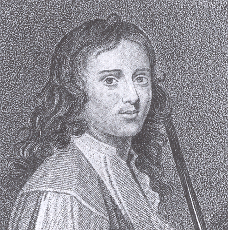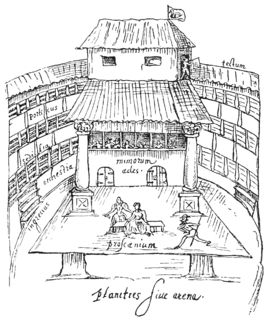The King's Men was the acting company to which William Shakespeare (1564–1616) belonged for most of his career. Formerly known as The Lord Chamberlain's Men during the reign of Queen Elizabeth I, they became The King's Men in 1603 when King James I ascended the throne and became the company's patron.

Michael Mohun was a leading English actor both before and after the 1642—60 closing of the theatres.

The Cockpit was a theatre in London, operating from 1616 to around 1665. It was the first theatre to be located near Drury Lane. After damage in 1617, it was named The Phoenix.

The Salisbury Court Theatre was a theatre in 17th-century London. It was in the neighbourhood of Salisbury Court, which was formerly the London residence of the Bishops of Salisbury. Salisbury Court was acquired by Richard Sackville in 1564 during the last seven years of his life when he was Chancellor of the Exchequer under Queen Elizabeth; when Thomas Sackville was created Earl of Dorset in 1604, the building was renamed Dorset House.
Beeston's Boys was the popular and colloquial name of The King and Queen's Young Company, a troupe of boy actors of the Caroline period, active mainly in the years 1637–1642.
Queen Henrietta's Men was an important playing company or troupe of actors in Caroline era in London. At their peak of popularity, Queen Henrietta's Men were the second leading troupe of the day, after only the King's Men.
The King's Revels Men or King's Revels Company was a playing company or troupe of actors in seventeenth-century England. In the confusing theatre nomenclature of that era, it is sometimes called the second King's Revels Company, to distinguish it from an earlier troupe with the same title that was active in the 1607-9 period. Since the earlier group was a company of boy actors, they are alternatively referred to as the King's Revels Children, while the later troupe is termed the King's Revels Men.
Theophilus Bird, or Bourne, was a seventeenth-century English actor. Bird began his stage career in the Stuart era of English Renaissance theatre, and ended it in the Restoration period; he was one of the relatively few actors who managed to resume their careers after the eighteen-year enforced hiatus (1642–60) when the theatres were closed during the English Civil War and the Interregnum.
John Rhodes was a theatrical figure of the early and middle seventeenth century. He rose to a brief prominence in 1660 when the London theatres re-opened at the start of the English Restoration era.
George Jolly, or Joliffe was an actor, an early actor-manager and a theatre impresario of the middle seventeenth century. He was "an experienced, courageous, and obstinate actor-manager" who proved a persistent rival for the main theatrical figures of Restoration theatre, Sir William Davenant and Thomas Killigrew.
John Honyman, also Honeyman, Honiman, Honnyman, or other variants, was an English actor of the Caroline era. He was a member of the King's Men, the most prominent playing company of its era, best known as the company of William Shakespeare and Richard Burbage.
Richard Sharpe was an actor with the King's Men, the leading theatre troupe of its time and the company of William Shakespeare and Richard Burbage. Sharpe began his career as a boy player acting female roles, then switched to male roles in his young adulthood.
John Thompson was a noted boy player acting women's roles in English Renaissance theatre. He served in the King's Men, the acting troupe formerly of William Shakespeare and Richard Burbage.
King's Men personnel were the people who worked with and for the Lord Chamberlain's Men and the King's Men from 1594 to 1642. The company was the major theatrical enterprise of its era and featured some of the leading actors of their generation — Richard Burbage, John Lowin, and Joseph Taylor among other — and some leading clowns and comedians, like Will Kempe and Robert Armin. The company benefitted from the services of William Shakespeare, John Fletcher, and Philip Massinger as regular dramatists.
Richard Gunnell was an actor, playwright, and theatre manager in Jacobean and Caroline era London. He is best remembered for his role in the founding of the Salisbury Court Theatre.
Nicholas Burt, or Birt or Burght among other variants, was a prominent English actor of the seventeenth century. In a long career, he was perhaps best known as the first actor to play the role of Othello in the Restoration era.
William Wintershall, also Wintersall or Wintersell, was a noted seventeenth-century English actor. His career spanned the difficult years of mid-century, when English theatres were closed from 1642 to 1660, during the English Civil War and the Interregnum.










